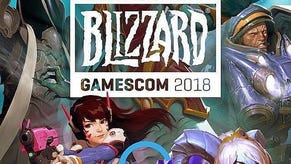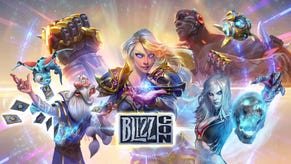Interview - VG247 Vs Blizzard's Rob Pardo
It's not every day you get flown to Blizzard's HQ in Irvine, CA, to see StarCraft II. And it's not every day you're given a chance to grill Rob Pardo, the firm's executive VP of game design, on the most anticipated strategy sequel of all time, Blizzard's development strategy, the new Battle.net, Natal, and an embarrassing amount more.
July 21 wasn't "every day," evidently.
Hit the link.
The answers below were given in response to questions asked by VG247 in a group interview.
VG247: You said in a recent interview that you build in-depth for the hardcore first, then work backwards in terms of making the game more accessible for more casual players. Is that design philosophy you employ across all of your products, or is that a product-specific thing?
Rob Pardo: Absolutely, it's something we do across all of our games. I'm a big believer that that's the right way to develop a multiplayer game, a game you really want to last for years and years. It's a little counter-intuitive, I think, in the games industry, in that more other companies tend to tack the multiplayer on at the end.
Just think from an hours-of-play standpoint. I think it's logical that if you want a game to last for 500-plus hours, which is something we strive for in all of our games, that you have to spend a lot of time making sure that your game has that much depth to it. And then you really want to put in that single-player element, read that story through, once you have those fundamental foundations of gameplay.
If you consider that single-player lasts anywhere from 20-50 hours, depending on the game, people go through it once, twice, maybe a few times, but multiplayer is really what has the longevity. It makes the game last for years and years.
VG247: Throughout StarCraft II's development, there's been a constant thread of questions about how to balance the needs of the hardcore and your need to bring in more casual players. To be blunt, do you even care about the "casual player"? It's a core RTS, right? Surely it's going to be a core player that's attracted to this game, whether or not they're a new StarCraft player?
Rob Pardo: Well, I think it depends on your definition of "casual player". I feel that "casual player" in general is a term we throw around to explain everyone from ourselves, as the every-gamer, down to the people that play PopCap games, down to the people that play Bejeweled on [the internet], so it really depends on your definition. Are we trying to get the moms to play? No. That's not really the market for StarCraft. But we certainly feel like we should be able to capture the gamer audience, even the people that are more on the casual gaming side, that maybe only buy two or three boxed products per year, all the way to the side of the player that plays five RTSes per year. We definitely want to get the entirety of that market.
VG247: You also said recently that single-player development started about halfway through the entire dev cycle. In hindsight, do you wish you'd started a bit earlier?
Rob Pardo: I don't know that it is possible to start earlier. Yeah, purely from a production point of view that'd be great; it'd be totally awesome if we could start single-player and multiplayer at the same time. But the reality is that we have to figure out the units. We want to be able to figure out what's fun. And a lot of our early development on all of our games is to get the multiplayer up and running really quick. We want to be able to play against each other as soon as possible in the dev cycle. Then we start designing the units, we start figuring out what's fun. How do we build a single-player campaign when we don't even know what the units are going to be in the game? We have to get a certain amount into the game so we can feel we can trust what's going to be there. If we start single-player too early then we're going to be throwing out mission constantly, which we still do even when we do start playing [multiplayer early]. The units change so much early in development, until we've got that multiplayer foundation in, that we can't really, seriously start work on the single-player.
Of course, we do lots of things like story development, and we talk a lot about the design, we come up with ideas like Story Mode and what we want to do with that, but we physically implement the levels until multiplayer's at maybe a 70 percent state of the unit design.
VG247: To put you on the spot specifically, what are you sales expectations for the game?
Rob Pardo: Sales expectations?
VG247: Yeah.
Rob Pardo: To do awesome. Is that too specific?
VG247: Do you expect sales of Heart of the Swarm and Legacy of the Void to hold up after Wings of Liberty? Do you expect them to be as successful as the main game?
Rob Pardo: I certainly hope so. In the past we've had a really good success rate with our expansions and add-on products. I don't know the numbers off the top of my head, but I know that back when you look at Brood War and Frozen Throne, we had well above 50 percent of people that bought the original bought the add-on. With WoW, because of the subscription model and the nature of the game, it's way beyond that.
VG247: Will they be priced as expansions?
Rob Pardo: Yeah. They'll be priced appropriately to the content. Right now the plans are to do something along the lines of full single-player campaign and some additional features on the multiplayer side, but obviously using the same engine. That to me is an expansion price point. If we decided to put in three new races, and a bunch of new technology and features, maybe that would be a standalone product. But right now I think we're looking at being much more like an expansion feature-set.
VG247: Have you made any final decisions on how you're going to recoup some of the investment you've made in the new Battle.net?
Rob Pardo: Yeah, we're still finalizing that. I know the big question out there is whether there's going to be a subscription to Battle.net or anything like that, and we certainly are not doing that for StarCraft II. Our approach on monetization and business model for a game is really what's right for the game. Just because something worked well on World of Warcraft doesn't mean we're going to put it on StarCraft II, because it's an entirely different sort of game. As far as what we do for Battle.net, we have a lot of different ideas, some other things that we're going to talk about, but nothing we're going to talk about here other than we're definitely not going to… I don't want to put the scare out there that it's going to be subscription-based. We're not going to do that.
I think what I've said previously is that we're going to take an approach that is a little bit micro-transactiony. You know, we have value-added services on World of Warcraft, where you can do paid character transfer, you can do the re-customization of your character, things that you really don't need to play the game. You can get pretty much anything you want out of World of Warcraft without any of the value-added services. I want to try to take more of that approach with StarCraft II and Battle.net. So it'll be things like if you want to rename your character. Things like that will be probably where we do the business model for Battle.net.
VG247: I've got to ask you about the LAN-exclusion, because that was a hot internet potato for a little while there. I checked this morning and almost 80,000 people now have signed that petition.
Rob Pardo: I still don't think that's up to the Diablo III art direction [petition].
VG247: Do you take note? Do you actually care, to be blunt?
Rob Pardo: Of course we care, but it's not like we're surprised that there's a petition about LAN in Star II. It's not like we went, 'D'oh. People care about that?' Clearly, we knew, It was a very tough decision, and I'd say we'd been talking about it back and forth for well over a year before we finally decided that this is more the direction for the future for us, and actually for the industry.
If you look at LAN, that goes back to the War II days, with Cali and stuff like that. I think LAN will be a great footnote in our history, just like DOS was. It's just something that, with broadband and with the connections and the things that we can do on Battle.net, and having to support LAN in addition to that… It's the sort of decision we have to make that has to be the lowest common denominator for both. I don't necessarily thing that's going to be the way of the future. And that's going to be the best thing for Star II and our future games.
I think we're going to support the real legitimate cases for LAN users. Like, in e-sports and the tournament community, we're really going to look into ways to have Battle.net work really well for those groups that have previously really needed LAN play. But outside of a couple of little niche groups that I think we can come up with other solutions, I think people are going to be really happy with this in the future.
VG247: I want to ask you about consoles for a moment. EA, Ubisoft and Microsoft have all made pretty high profile RTS pushes onto consoles in this generation, with varying levels of success. How would you view what's happened, because almost to a man they've retreated.
Rob Pardo: I think the reason is that it's hard to make a great consoles strategy game, and I think what they're trying to do is take great PC strategy games and turn them into consoles games rather than developing consoles strategy games from scratch. I think there's lots of designs out there that can do it, I just don't know… There's apparently no developers out there with the passion, talent and desire to do it right now.
VG247: So you think that the people who developed Halo Wars didn't have passion or talent?
Rob Pardo: No, I think they took what's a great PC game and tried to turn it into a console experience, and I think they had varying levels of success. And I think you see the same thing when you take , let's say… The classic game example is fighting games on the PC. Have you ever seen a great fighting game on PC?
Other journo: Yes. Street Fighter IV? Guilty Gear X?
Rob Pardo: You think that's better than on console?
Other journo: It looks better. It's difficult because it's a point on gameplay, but let's say it's very similar.
Dustin Browder: As long as I can hook up a control pad I guess it would be the same. At that point I don't know what the difference is. I wouldn't want to play it with a keyboard, but I would with a nice six-button controller.
Rob Pardo: I don't think that's a valid argument, and I'll tell you why. You can take a keyboard and a mouse and you can play it just fine on console; that doesn’t mean it's not a great game. What we're talking about is commercial success, right? And when you're talking about the big console groups, they're not really focused on MetaCritic. They're focused on commercial success. And having a commercially successful game on console that plays better on keyboard and mouse is a no-go. Just like having a commercially successful fighting game on PC that requires a game-pad to be as good. It's a no-go, right?
VG247: So what is actually stopping strategy working on consoles?
Rob Pardo: Designing games around a game controller.
Dustin Browder: I dunno. I love Civ Rev. It's not real-time strategy, but it's still an example of a game that was modded specifically for a console. And it made a successful translation.
Rob Pardo: It's still modded though.
Dustin Browder: It is.
Rob Pardo: The example to go with - and again, this wasn't hugely commercially successful – but it's great example of a game that was designed for console, is Pikmin. Another really good example on the PlayStation in PixelJunk: Monsters. Games that are basically designed around having a controller. It's a strategy game around a controller, and I think that's what needs to happen if you want to see great consoles strategy games.
I think a lot of this is because typically, strategy requires more complexity, so that tends to lend itself to a keyboard where you have lots of hot-keys and commands. There just hasn't been a lot of simple strategy games that go to console. I think it's totally doable, it just that it would require a lot of risk and innovation. Typically, your bigger publishers only do so many of those plays. They would rather stick to their franchises, and make a couple of bets on innovative products.
VG247: I had a chat with Michael de Plater [dev lead on Ubisoft's Endwar – Ed] last week, and he was very excited about Natal. He thought that the pad-less interface could really help RTS on console come into its own. Have you got a view on that?
Rob Pardo: I don't know. I hadn't thought of it before. Maybe he's seen something I don't see. I've got to play with Natal a little bit, and it seems like the difficulty with it is still spatial recognition with moving your hands and doing things. And it seems still the precision of a strategy game is being able to type on a keyboard, because I have, like, 30 commands that are instantly available. I'm not sure how Natal helps with that. It seems that if Natal was going to be opening up the market then the Wii would be opening it up too for strategy.
VG247: He was talking about a Minority Report-style experience, where you drag and select with your hands.
Rob Pardo: Yeah, but you'd actually still need an interface that you could do that with, and Natal is still going to be pretty imprecise in the way Wii is today. I mean, I could see the future one day [allowing it], but I don't know if Natal's it. Maybe it's a step towards it. But again, I've thought about it for all of five seconds right now, so there could be some genius there that I don't immediately see.
VG247: Do you think that, ultimately, it'll be the multiplayer or single-player that determines the final success, in your eyes, of StarCraft II?
Rob Pardo: Hopefully both. I mean, they kind of have different measures of success. Certainly, single-player is a shorter burst. Long term I think people are going to look at the multiplayer, because that's what's going to stand the test of time more, because most time when you read a book, or do a single-player experience, you do it once or twice. But that doesn't mean they don't influence each other quite a bit. I feel like one of the reasons StarCraft has been successful is because it had that story, and it had those strong characters, and you identify with it and personalize with it much more than other RTSes that only focus on multiplayer.
I really think they become very interwoven with one another, and I don't really think you can break them apart. When you start looking back in time, right, when you start looking at the game, like Warcraft III: is that game defined by the mod scene, is it defined by multiplayer, is it defined by single-player, is it defined by all the story that WoW's been built upon? It's all of the above.
Interview by Patrick Garratt.









